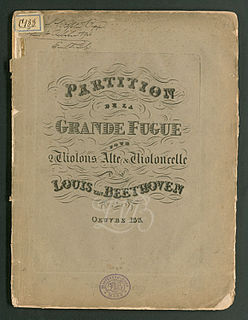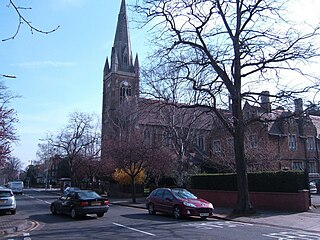An American in Paris is a jazz-influenced orchestral piece by American composer George Gershwin first performed in 1928. It was inspired by the time that Gershwin had spent in Paris and evokes the sights and energy of the French capital in the 1920s.

Rhapsody in Blue is a 1924 musical composition by the American composer George Gershwin for solo piano and jazz band, which combines elements of classical music with jazz-influenced effects.

Alan Hovhaness was an American composer. He was one of the most prolific 20th-century composers, with his official catalog comprising 67 numbered symphonies and 434 opus numbers. The true tally is well over 500 surviving works since many opus numbers comprise two or more distinct works.

In music, a motif(pronunciation) (help·info) is a short musical phrase, a salient recurring figure, musical fragment or succession of notes that has some special importance in or is characteristic of a composition: "The motive is the smallest structural unit possessing thematic identity".
American classical music is music written in the United States in the European classical music tradition. In many cases, beginning in the 18th century, it has been influenced by American folk music styles; and from the 20th century to the present day it has often been influenced by American folk music and sometimes jazz.

The Große Fuge, Op. 133, is a single-movement composition for string quartet by Ludwig van Beethoven. An immense double fugue, it was universally condemned by contemporary critics. A reviewer writing for Allgemeine musikalische Zeitung in 1826 described the fugue as "incomprehensible, like Chinese" and "a confusion of Babel." However, critical opinion of the work has risen steadily since the beginning of the 20th century, and it is now considered among Beethoven's greatest achievements. Igor Stravinsky said that "[it is] an absolutely contemporary piece of music that will be contemporary forever."

Martin Berkofsky was an American classical pianist, known primarily for his interpretations of music by Franz Liszt and Alan Hovhaness.

The music of the Star Wars franchise is composed and produced in conjunction with the development of the feature films, television series, and other merchandise within the epic space opera franchise created by George Lucas. The music for the primary feature films was written by John Williams. Williams' scores for the nine saga films count among the most widely known and popular contributions to modern film music, and utilize a symphony orchestra and features an assortment of about fifty recurring musical themes to represent characters and other plot elements: one of the largest caches of themes in the history of film music.
Kenneth A. Radnofsky is an American classical saxophonist. He specializes in the alto saxophone, but plays the soprano and other sizes as well. He currently teaches at the New England Conservatory of Music, the Longy School of Music, and Boston University.

Arno Babajanian was an Armenian composer and pianist during the Soviet era.
Fantasy on Japanese Woodprints, Op. 211 (1965), is a concerto in one movement written for xylophone and orchestra by the Armenian-American composer Alan Hovhaness.
Third Stream is a synthesis of jazz and classical music. The term was coined in 1957 by composer Gunther Schuller in a lecture at Brandeis University. Improvisation is generally seen as a vital component of third stream.
Lisa Carol Bielawa is a composer and vocalist. She is a 2009 Rome Prize winner in Musical Composition and spent a year composing as a Fellow at the American Academy in Rome.

Prelude and Fugue on a Theme of Vittoria is a work for solo organ composed by Benjamin Britten in 1946. It was commissioned for St Matthew's Church, Northampton and first performed on 21 September 1946, St Matthew's Day, three days after its composition. It uses a theme from a motet by the Spanish composer Vittoria, both in the prelude and as the basis for the fugue. The piece, which lasts about five minutes in performance, has had a mixed reception. One writer has noted the difficulty on finding a suitable organ on which to perform the piece, given the difficulties in finding appropriate registration to meet Britten's requirements. A reviewer of a concert performance in the 1960s called it "a contrived attempt to make bricks without straw", although other commentators have been more favourable about the piece.
Symphony No. 2, Op. 132, Mysterious Mountain is a three-movement orchestral composition by the Armenian-American composer Alan Hovhaness. The symphony was commissioned by the conductor Leopold Stokowski and the Houston Symphony, and premiered live on NBC television in October 1955 on the Houston Symphony's first program with Stokowski as conductor. The first and most popular recording of the work, released in 1958 with the Chicago Symphony Orchestra performing under Fritz Reiner, is often regarded as the foremost performance of the piece. This recording, like early performances of the work, predates the composer's decision to categorize the work "symphony". Later on, the G. Schirmer published score was titled Mysterious Mountain with "Symphony No. 2" printed as a subtitle in smaller typeface.
Symphony No. 50, Op. 360, Mount St. Helens is a three-movement orchestral composition by the American composer Alan Hovhaness. The symphony was commissioned by former Hovhaness publisher C.F. Peters and was completed January 24, 1982. It premiered March 2, 1984, and was performed by the San Jose Symphony under conductor George Cleve. The piece commemorates the volcano Mount St. Helens, culminating in the events of its 1980 eruption, which Hovhaness had witnessed from his Seattle home.
The Symphony No. 1, Op. 17, Exile is the first symphony by the American composer Alan Hovhaness. The piece was composed in 1936 and was premiered by the BBC Symphony Orchestra under the conductor Leslie Heward in 1939. The work commemorates the genocide of the Armenian people, including Hovhaness's paternal family, during the Ottoman Turkish occupation of World War I. The symphony is dedicated to English writer and philosopher Francis Bacon.
The Symphony No. 66, Op. 428, Hymn to Glacier Peak is an orchestral composition in three movements and the penultimate symphony by the American composer Alan Hovhaness. The work was commissioned by the Seattle Youth Symphony Orchestra and was completed in 1992, shortly before its premiere by the Seattle Youth Symphony, conducted by Ruben Gurevich, at the Seattle Opera House on May 10, 1992. The title of the work comes from the stratovolcano Glacier Peak in the Cascade Range, visible from Hovhaness's home in Seattle, Washington.
Rhapsodies for Orchestra is a single-movement orchestral composition by the American composer Steven Stucky. The work was jointly commissioned by the New York Philharmonic and the BBC for the Philharmonic's European tour in August and September 2008. The piece had its world premiere August 28, 2008 in Royal Albert Hall at The Proms, with the New York Philharmonic performing under conductor Lorin Maazel.
The Symphony No. 63, Op. 411, Loon Lake is a symphony for orchestra in two movements by the American composer Alan Hovhaness. The work was commissioned in September 1987 by the New Hampshire Music Festival and the Loon Preservation Society. It was completed in early 1988 and premiered August 18, 1988, with conductor Thomas Nee leading the New Hampshire Music Festival Orchestra. The ending of the piece was later revised by Hovhaness at the request of his wife; the revised symphony premiered July 2, 1991, and is the only version available on recording.







